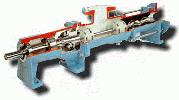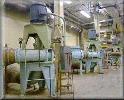Sludge Pumps...
In general, the progressive cavity pumps have been used successfully on almost all types of sludges. The pump is
composed of a single - threaded rotor that operates with a minimum of clearance in a double - threaded helix stator made
of rubber. A volume, or cavity, moves progressively from suction to discharge as the rotor turns. The pump is self
- priming at suction lifts up to 8.5 m, but it must not be operated dry because it will burn out the rubber stator.
It is available in capacities up to 75 L/sec and may be operated at discharge heads of 137 m on sludge.
Advantages of the pumps are; easily controlled flowrates, minimal pulsation, and relatively simple operation.


Sludge Piping...
In treatment plants, conventional sludge piping should not be smaller than 150 mm in diameter, although
smaller diameter glass - lined pipes have been used successfully. Pipe sizes need not be larger than 200 mm, unless
the velocity exceeds 1.5 to 1.8 m/sec, in which case, the pipe is sized to maintain that velocity. Gravity
sludge withdrawal lines should not be less than 200 mm in diameter. It is common practice to install a number of
cleanouts in the form of plugged tees or crosses instead of elbows so that the lines can be rodded if necessary. Pump
connections should not be smaller than 100 mm in diameter.













